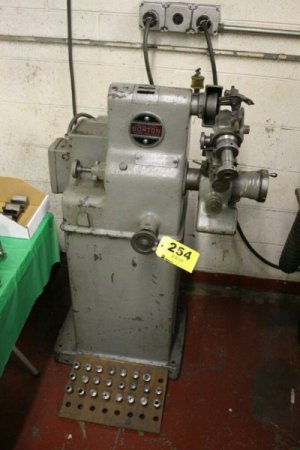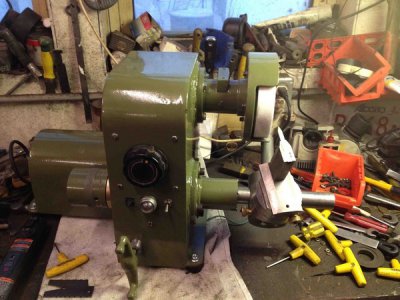Hi all,
I have a very nice Gorton single lip grinder, model 375-2, which i picked up at auction a while back. I finally got around to cleaning it up and playing with it. I'd like to use it for accurately grinding lathe tools, and occasionally making single lip milling form cutters. I have a couple of quick questions:
- for grinding a 60 degree threading tool, how is the right side of the tool ground? The tool holder has just enough swivel motion to get the tool the 30 degree off axis, but then the "plunge" motion of the holder assembly is in the wrong direction. If anyone can direct me to some examples of actually using this type of grinder, I'd really appreciate it! There are only a few examples on youtube, mostly in chinese.
- grinding a ball-end cutter (or a convex radius lathe tool) seems pretty straightforward using the included radius swivelling holder. Is it possible to grind a concave tool with this machine though? I can't figure out how that would be done, but it seems like it would be the more commonly useful type of tool (corner-rounding, for example)
Thanks very much!
Lee

Sent from my SM-N920T using Tapatalk
I have a very nice Gorton single lip grinder, model 375-2, which i picked up at auction a while back. I finally got around to cleaning it up and playing with it. I'd like to use it for accurately grinding lathe tools, and occasionally making single lip milling form cutters. I have a couple of quick questions:
- for grinding a 60 degree threading tool, how is the right side of the tool ground? The tool holder has just enough swivel motion to get the tool the 30 degree off axis, but then the "plunge" motion of the holder assembly is in the wrong direction. If anyone can direct me to some examples of actually using this type of grinder, I'd really appreciate it! There are only a few examples on youtube, mostly in chinese.
- grinding a ball-end cutter (or a convex radius lathe tool) seems pretty straightforward using the included radius swivelling holder. Is it possible to grind a concave tool with this machine though? I can't figure out how that would be done, but it seems like it would be the more commonly useful type of tool (corner-rounding, for example)
Thanks very much!
Lee

Sent from my SM-N920T using Tapatalk


